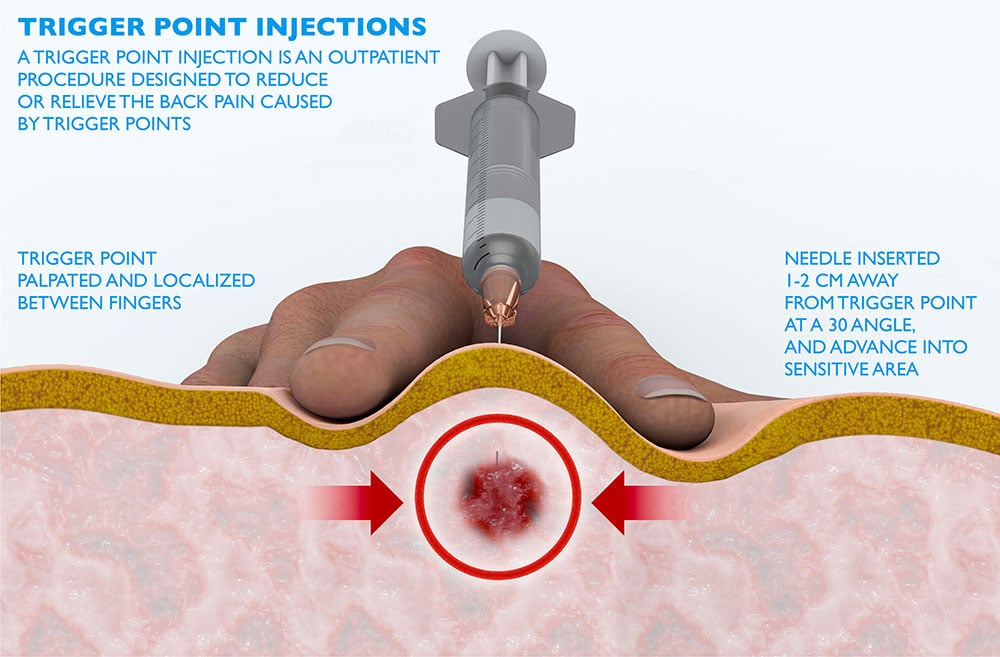Overview
Trigger points are described as tender points, spasms or hyperirritable areas in the muscles. Patients typically can feel the trigger points as nodules that are painful to pressure. Most common locations for trigger points are neck, upper and low back. Trigger point injections are a quick injection performed at the locations to provide rapid relief and decrease both pain and muscle spasms.

How is the procedure performed?
Our team will help position you to make sure the procedure can be completed with the least amount of discomfort for you. The skin is cleansed with a sterilizing solution (chlorhexidine). A fine needle attached to a syringe is inserted in the trigger point. The needle may be moved around the trigger point to reduce the spasm before injecting medication. A local anesthetic and/or steroids is then injected. During the entire procedure you will be constantly monitored by our team. After the injection a small bandage is placed on your skin. You will be given time after the procedure to make sure you feel good and are not having side-effects before leaving the clinic.
What medication is injected?
The injection includes a combination of anesthetic (lidocaine or bupivacaine) and sometimes steroid (cortisone, Kenalog or dexamethasone).
Does the procedure hurt?
The procedure is typically well tolerated. A localized burning sensation from the anesthetic is commonly felt and is usually the most uncomfortable part of the process. During the procedure a pressure sensation is often experienced this typically resolves within a few minutes. Minor soreness for a week after the procedure is normal.
How long does the procedure take?
The procedure typically takes about 15 minutes to perform. Please plan on being at the clinic for about 1 hour to allow for pre and post-procedural safety protocols.
How quickly will I get relief?
Patients typically get relief the day of the injection. It can take up to a week to reach full effectiveness. Our team will follow-up with you and determine the need for any future injections.
How long can I expect the relief to last?
Every patient is different. Most patients get reduced pain lasting 1-4 months. Some patients can get relief lasting greater than a year.
How often can the procedure be repeated?
Depending on results and providers discretion the injections may be repeated monthly as needed.
Will the steroid injection result in more health problems long term?
There is minimal absorption from steroid injections to other areas of the body. For this reason, many of the side effects that occur with systemic steroid usage do not occur with local steroid injections. The systemic side effects of weight gain, osteoporosis (thin bones), and increased blood pressure typically do not occur with steroid injections.
Can I have the injection if I have diabetes?
Yes. It is important to control your blood sugar before and after the injection. Diabetic patients may experience a temporary increase in blood sugar which should resolve in a few days after the procedure.
What are the risks and side effects?
Risks and side effects are minimal and serious complications are rare. We take every precaution to ensure safety. Potential risks may include but are not limited to: vasovagal response (passing out), new or increased pain, infection, bleeding, permanent skin changes, allergic or unexpected drug reaction with minor or major consequences, and unintended nerve injury.
Pre-Procedure Information
Please let us know if you have an active infection, are using antibiotics, or are using blood thinners.
Should I take my normal medications as scheduled?
Yes. Continue taking your prescribed medications prior to procedure.
What If I am on a blood thinner or Aspirin?
Anticoagulation typically can be continued.
Do I need a driver?
Yes. For your safety we require a driver to ensure safe return home.
Can I eat the day of the procedure?
We recommend eating a light meal if the injection is done in our clinic.
Can I get sedation or anesthesia?
No sedation is necessary for this procedure.
What should I wear?
We recommend light loose-fitting clothes. Sometimes we will ask you to change into a gown.
Post-Procedure Information
When can I drive after the procedure?
We recommend resuming driving the next day.
What can I do if I am sore or have pain after the procedure?
Ice packs can be applied to the area for 20 minutes per hour. Over the counter Tylenol and Motrin can be used to aid with any discomfort.
What are my restrictions after the procedure?
Typically, you may resume light activities on the same day following your procedure. Physical therapy can be re-started within 24 hours. We recommend returning to work the day after the procedure.
When can I shower?
Showering the day of the procedure is allowed. For 24 hours you are asked to refrain from submerging or swimming in water. Keep the bandage on for one day.
When do I come back for a follow-up visit?
We follow-up with all of our patients after their procedures. We typically see patients back in 2-4 weeks.
